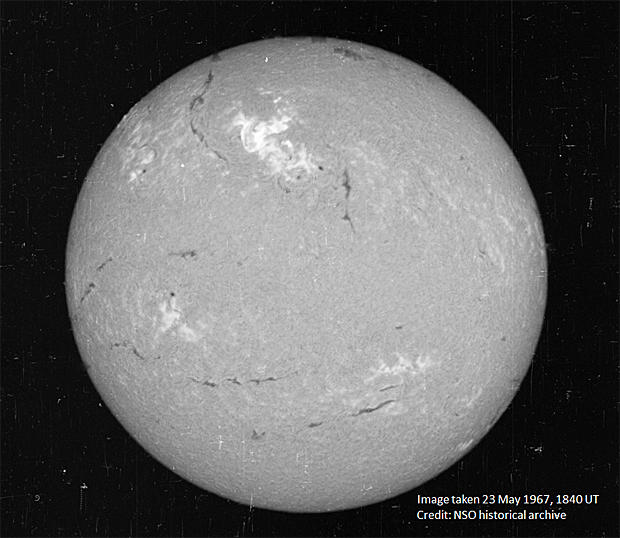.
On May 23, 1967, three missile early warning system radar installations suddenly showed signs of jamming, raising the possibility, however remote, of a Soviet sneak attack. With the radars out of action, Pentagon planners were operating "in the blind," unable to know if enemy missiles could be be heading toward a first strike.
With long-range nuclear-armed bombers already in the air on normal "alert" patrols, additional bombers were put on "ready to launch" status as options were debated, researchers reported Tuesday. At the height of the Cold War, an attack on early warning radars was considered an act of war.
Luckily, well before President Lyndon Johnson might have been forced to make any irrevocable decisions, a small contingent of "space weather" forecasters working for the North American Aerospace Defense Command, or NORAD, was able to convince the chain of command that a powerful solar storm, not the Soviet Union, was jamming the radars.

In this archived view of the sun, captured on May 23, 1967, a bright region near top center shows where a large flare occurred, part of a series of outbursts that affected communications -- and military radar systems -- on Earth.
It wasn't quite the "nick-of time" intervention one might expect at the end of a thriller. But it was an uncomfortable reminder of the high stakes involved, the increasing reliance on high technology and communications problems, or crosstalk, that can combine to trigger an unintended -- and potentially disastrous -- consequence
Delores Knipp, a space physicist at the University of Colorado at Boulder and author of a paper accepted by the journal Space Weather that describes the incident, told CBS News that Air Force space weather officers with NORAD were trying to convince the chain of command that the solar storm was causing the problem even while the Strategic Air Command was placing additional aircraft on "ready to launch" status.
"The information from NORAD and SAC apparently was crossing at the Pentagon before it went to the president," Knipp said. "The president had to approve anything that was going to involve really drastic actions. I frankly don't know if he had to approve launch of additional aircraft or not.
"So therein lies that little bit of uncertainty in terms of were we on the verge or were cooler heads prevailing all along? And that is not something that I or maybe even my co-authors had privy to. What we do know is that the aircraft did not launch."
Five days earlier, on May 18, 1967, a large group of sunspots with intense magnetic fields rotated into view and observers with the Air Force's Air Weather Service predicted a major solar storm.
On May 23, observers noted a major visible light flare and a solar observatory in Massachusetts detected and reported unprecedented radio emissions. A bulletin from NORAD predicted a major geomagnetic storm.
"There were a series of three bursts from the sun," Knipp said. "The second one started to bring down or severely degrade the kind of communications SAC (Strategic Air Command) would use communicating with its aircraft.
"So things were already kind of edgy," she said. "Then the third burst, which looked smaller in some wavelengths, actually became an unprecedented large event in terms of a radio burst. And it was the third event that really started the degradation of the BMEWS."
Retired Colonel Arnold Snyder, a solar forecaster at NORAD's Solar Forecast Center who was on duty that day, remembers that another weather officer told him the NORAD command post wanted to know if any significant solar activity was occurring.
"I specifically recall responding with excitement, 'Yes, half the sun has blown away,' and then related the event details in a calmer, more quantitative way," Snyder told the American Geophysical Union.
Knipp agreed, saying the sun was "unbelievably busy that day."
So why was there ever any doubt about what was causing the radar problems?
"It's hard to put ourselves back 50 years and realize they were operating with the barest essential information," Knipp said. Along with two radars that could be used to indicate the effects of solar activity, "they had phone lines and the teletype. And that was it."
While the space weather forecasters were studying data coming into the NORAD solar forecasting unit, "at the same time there was stuff coming downhill, so to speak, from operators at NORAD saying 'my heavens, what is going on here?'" Knipp said. "All of that information had to be integrated. And it was pretty basic information. It's not what we have today with spacecraft eyes on the sun 24/7."
In the aftermath of the incident, the Air Force greatly expanded space weather forecasting and observations to better understand the sun's behavior and its effects on sensitive electronic systems.
"AWS (Air Weather Service) notified NORAD in real-time of the event and the associated mission impacts," according to the paper submitted to Space Weather. "However, outside agencies were not aware of the space environmental factors and made uninformed decisions without considering the drastic impacts the event imparted to NORAD's early warning systems, which have a direct bearing on decisions being made at the highest levels of the US government.
"As a result of this near-incident, the need to incorporate real-time space weather information into the Air Force decision-making process was made obvious to many, and several major efforts were undertaken to greatly improve the operational capability of the AWS Space Environmental Support System."
And it wasn't just the U.S. and its allies that made changes. Russia was paying attention, too. Knipp said a Russian colleague now working for the National Solar Observatory told her that the Soviet Union sharply increased funding for solar observatories and research in the aftermath of the 1967 solar storm.
Quelle: CBSNEWS
